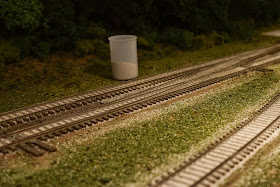
Over at Trevor Marshall's
Port Rowan in S scale blog (that's Trevor Marshall of the incomparable
The Model Railway Show podcast), the talk is about runnin' trains--you read that right, just plain ol' running of trains, just to see them go.
In
a recent post, Trevor recounts the experience of a friend who visited a famous model railroader's large home layout:
My friend took along some beer as a thank you for imposing on the [Famous Model Railroader’s] time and after a tour of the layout room tour in which he ooohed and aaahed appropriately, my friend asked, “So, FMR, why don’t we run a train or two?”
The answer was, “No, I don’t think there are any trains scheduled to run on the railroad today.”
As you can imagine, my friend was ready to take back his beer – perhaps to help wash out the sour taste the experience left in his mouth. Now imagine how this attitude would go over with someone who is not already in the hobby. After an experience like that, chances are they never will be.
Trevor goes on to discuss informal train operations that are probably similar to what we'll eventually see at Dunes Junction, but I realized once again that one of my key model railroading goals is to create community--not to turn people away or cause people to not want to share beer (heaven forbid!).
I can't imagine getting really excited about model railroading that pushes people away or excludes new or non-modelers. Thus my decided indifference to this 'serious' model railroading that has seems to have little regard for newcomers or outsiders.
When visitors to our home look at the a-building Dunes Junction, I can explain the concept in one simple sentence: these are my favorite trains and places from my youth back in Indiana. All but the littlest visitors grasp this immediately, and understand why I go to all the effort of fancy trees, exactly colored track ballast, DCC, rare models from eBay, and other geekery. I have a stepstool for the little ones that just like the trains and lights and horns, and they 'get' it for other equally valid reasons.
Another model railroad blog,
Some Railroad You've Never Heard Of, also touched on model railroading's 'serious' problem recently. What caught my eye first in a post titled '
Model Railroad: From Family Room to Basement' was a happy picture of the blogger, his wife, and their newborn baby.
Some Railroad's author, Titus, is focused on narrow gauge and advocates a Do-It-Yourself approach to our hobby. But Titus reflects a bit on the connection between his slim gauge modeling and that wife and little baby. "What," he asks, "will my friends and family like the most or be the most engaged in regarding my layout?"
What if we start making decisions on our layouts, influenced by prototypes, but based on what would draw in our friends and family more? Would that actually free us to make the compromises we know we need to make, without second guessing them the entire way through? Would that allows us the freedom to enjoy our layout with others because we aren't consumed with an unholy pursuit of perfection? Might we just find that others can enjoy our layout just as much as we can, which gives our railroads a purpose outside of moving passengers and freight around a mini world?
Here's hoping that Titus's little narrow gauge railroad plants a little seed of interest, of curiosity, of imagination in the mind of his wife's and his new child. She doesn't need to become a model railroader for that layout to be a success. Patient grownups and their sometimes fanciful model railroads opened for me and many others a whole world of non-railroading interests and possibilities.
Little kids, neighbors, and party guests are part of Dunes Junction's audience. They're not the only reason I'm building Dunes Junction, but they get to be part of the audience. And hopefully they all walk away with something more than what they came in with.





